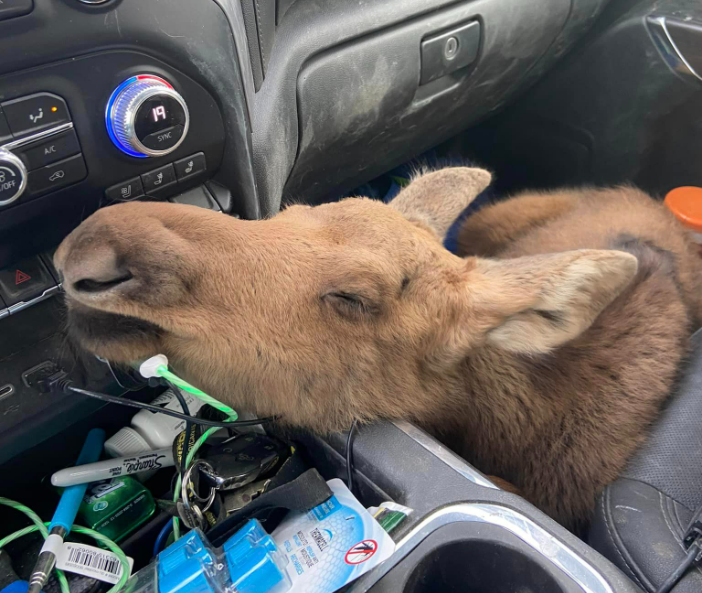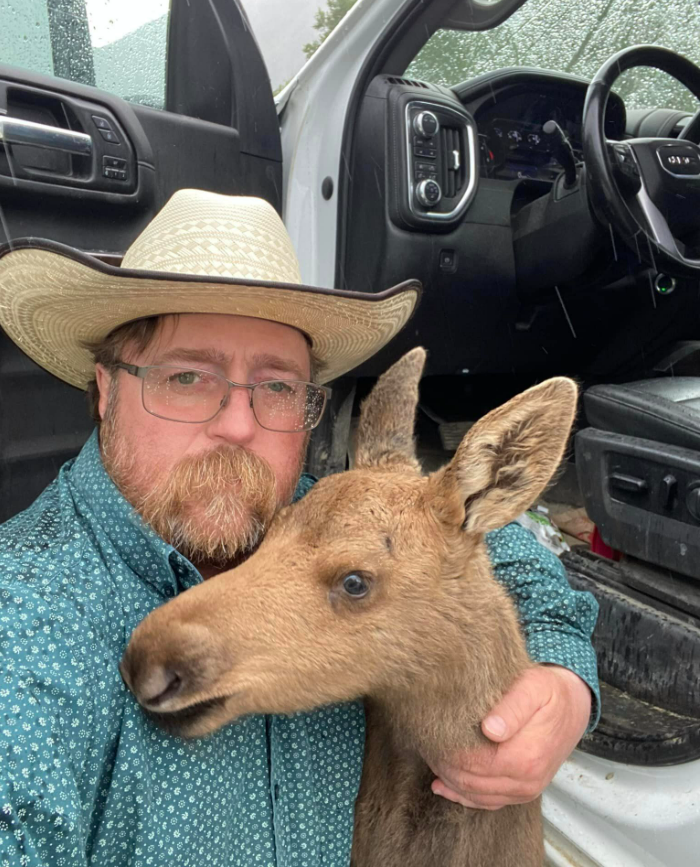More than a month after she was picked up off of a northern B.C. highway and driven about five hours south in a pickup truck to Fort Nelson, a small moose calf named “Misty” is in good health and spirits.

The update comes from the Rimrock Wildlife Rehabilitation Centre near Dawson Creek, a certified facility that took her in from the B.C. Conservation Officer Service (COS) on June 7.
She’s now receiving food and medicine as needed, living on a 400-acre property with other young ungulates around her age.
“She’s fitting in well here. She shouldn’t have a problem being rehabbed,” said Jason Harvey of Rimrock Wildlife.
“We’re giving her the best chance she has to be released.”

On June 6, Fort Nelson resident Mark Skage put Misty in his work truck after observing her alone on the side of the Alaska Highway. Video shared on Facebook shows the calf crossing the road to join him and peering in his vehicle as he asks her, “Where’s mom?”

Skage told Global News on Saturday that despite his initial intentions to scare the calf back into the woods, he saw a black bear nearby and decided to take her in. He said he called his employer and the B.C. COS as soon as he had cell service, hoping something could be done to keep her safe once he got back to town.
“It didn’t want to be outside no more,” Skage explained. “She came to me and I decided I’d answer the call.”
Skage was later fired by his employer, AFD Petroleum, which said he breached workplace protocols and never called the B.C. COS. The company further shared two-way video from inside the truck that shows Skage hoisting the calf into the truck.
The video does not appear to show a black bear nearby, and AFD doesn’t believe it shows Skage thoroughly searching for the calf’s mother either.
“We take our obligation to wildlife and to our natural environment extremely seriously. The only actions which put the animal in danger were those of Mr. Skage,” AFD president Dale Reimer wrote in an email to Global News.
Both Skage’s firing, and his decision to pick up and move the calf, have created a buzz on social media with users expressing both support and outrage.
Angelika Langen, co-founder and manager of the licensed Northern Lights Wildlife Shelter in Smithers, said a moose calf should never be picked up unless it is visibly injured or there is confirmation that its mother is dead. It may be safe to move an injured animal to the side of the road, she added, but transportation shouldn’t be attempted without contacting a shelter or the B.C. COS.
“A healthy animal should never be taken unless it’s been observed for a lengthier period of time or there is a clear knowledge of the mother being killed,” she said Monday. “Even a young moose can be quite dangerous.”
Langen said moose can carry diseases that can be passed onto humans — one more reason to involve a professional.
Speaking about Misty’s case in particular, she said it’s possible that if a black bear were there, it may have been foraging and not interested in the calf at all. Drawing any attention to the calf, however, could instigate hunting behaviour, she added.
“I know it’s really difficult, but from personal experience I can only say that they are putting the animal in more danger than helping. Especially moose babies, are very hard to raise in human care,” Langen said.
“Despite their size, they’re very susceptible to illnesses. We’ve been doing this for over 30 years and we only have about a 50-per-cent success rate in raising moose calves.”

According to the B.C. Wildlife Act, it is illegal to be in possession of — or to transport — wildlife without a licence or permit, or outside of the circumstances allowed under the law.
The B.C. COS has said it is investigating the circumstances around “the alleged unlawful possession of a moose calf near Fort Nelson” on June 6.
“The individual was advised about the legalities of possessing live wildlife,” the COS said in an emailed statement.
Harvey, meanwhile, described the calf as healthy and happy, having arrived in “good condition.”
“Her chances of survival in the wild are pretty good. Last year we had a 100-per cent success rate with all the animals we released,” he said. “It’s really dependent on the weather we have, the amount of snow and the predators.”
The goal is to release Misty, another moose calf and a fawn around Oct. 31, he added. Where they are released will depend on the weather, the predators in the area, and an evaluation of their individual susceptibility to hunters.
B.C. Environment Minister George Heyman was not available for an interview Monday, and his ministry said no COS officers were available to provide advice on what motorists should do if they find a moose calf on the road.
While AFD said Skage’s firing was the result of multiple workplace incidents, including the moose calf, Skage told Global News he has no regrets.
“I believe that in this world, we need to stand up for our values and beliefs, and do what we think is right regardless of the consequences,” he said.
“No harm came to that moose, no harm came to that company pickup truck, no harm came to anybody else along the way.”
According to a 2002 article published in the Journal of Wildlife Management, predation was responsible for 92 per cent of all moose calf deaths in Eastern Interior Alaska, with black bears making up 45 per cent of the kills.






Comments